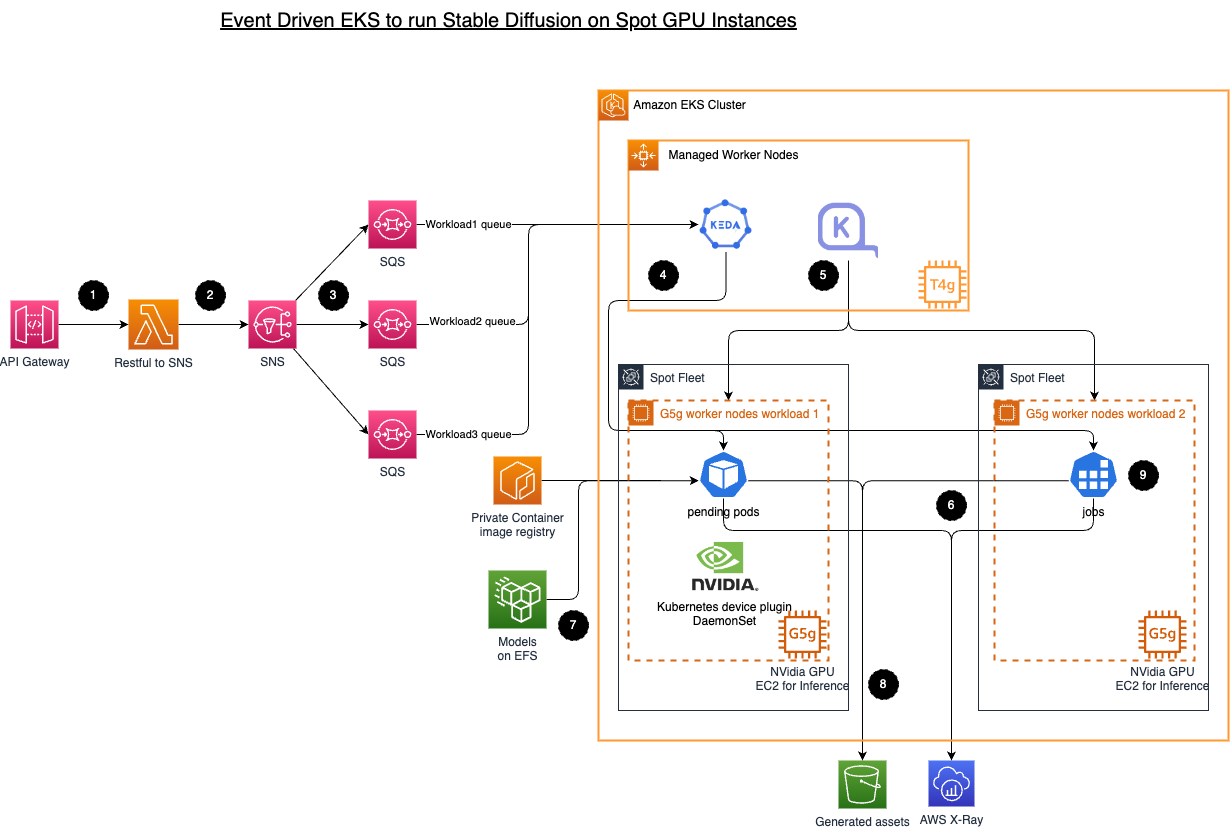This repository contains infrastructure as code (IaC) using CDK to set up a robust and scalable environment for running stable diffusion workloads on-demand. The infrastructure is designed to efficiently handle workload submissions through an API gateway, manage message routing using Amazon Simple Notification Service (SNS) and Amazon Simple Queue Service (SQS), scale resources dynamically with Kubernetes Event Driven Autoscaling (KEDA), and provision GPU worker nodes on-demand using NVIDIA Bottlerocket and Karpenter provisioner.
The infrastructure follows an event-driven architecture, where user-submitted stable diffusion workloads are processed through the following steps:
- Users submit stable diffusion workloads through an API gateway.
- A Lambda function backed by the API gateway posts the message to Amazon Simple Notification Service (SNS).
- SNS routes the message to different Amazon Simple Queue Service (SQS) queues based on subscription filtering.
- Kubernetes Event Driven Autoscaling (KEDA) listens to the respective queues and scales up the appropriate resources (ScaledObject or ScaledJob) based on workload demands.
- When a pod is pending, the Karpenter provisioner provisions GPU worker nodes using Spot instances with NVIDIA Bottlerocket, pre-installed with the GPU driver.
- Each pod consists of three containers: the queue manager, the stable diffusion API endpoint, and an AWS X-Ray sidecar for monitoring.
- The models are hosted in Amazon Elastic File System (EFS) and shared with the pods using ReadWriteMany (RWX) Persistent Volume Claims (PVC). Note: ReadOnlyMany (ROX) is not supported by EFS CSI yet.
- Once a health check on the stable diffusion API is successful, the queue manager triggers the stable diffusion API, waits for a response, and writes the result into Amazon S3.
- If the workload is handled by a ScaledJob, the queue manager sends a stop API request to the Stable Diffusion API and sends a SIGTERM signal to the X-ray sidecar to mark the job as complete.
.
├── bin
├── lib
│ ├── addons
│ ├── resourceProvier
│ ├── runtime
│ │ └── sdRuntime.ts # Generates the HELM values
│ ├── utils
│ └── dataPlane.ts # The stack with EKS Blueprint
├── config.js # configuration for your stack
└── ...
.
├── src
│ └── backend
│ │ ├── queue_agent # Queue manager for ScaledObject
│ │ ├── queue_job # Queue manager for ScaledJob that kills other container upon job completion
│ │ └── sd_webui_api # Cloned with modification from https://github.com/antman2008/stable-diffusion-webui-dockerfile
│ ├── charts
| │ └── charts
| | └── eks-keda-sd
│ └── frontend
| └── input_function
| └── app.py
└── ...
- Clone this repository:
git clone --recurse-submodules https://github.com/your-username/your-repo.gitBuild the 3 container images in the src/backend folder and push to ECR.
In the scripts/bottlrocket-images-cache folder, runs the snapshot.sh with the 3 images as the runtime parameers separated by commas.
Copy the snapshotId and update the config.js
-
Configure
config.jsaccording to your environment and runcdk deployfrom the root folder. -
Monitor and manage your stable diffusion workloads through the Kubernetes dashboard or CLI tools.
- CDK will show Outputs upon completion as follow:
Outputs:
<stack name>.ConfigCommand =
<stack name>.FrontApiEndpoint =
<stack name>.GetAPIKeyCommand =
- use
curlto post a test data to<stack name>.FrontApiEndpointwith the API key obtained from<stack name>.GetAPIKeyCommand, for example:
curl -X POST <value of <stack name>.FrontApiEndpoint> \
-H 'Content-Type: application/json' \
-H 'x-api-key: <value of <stack name>.GetAPIKeyCommand>>' \
--data-raw '
{
"sdname": "sdruntime-jobAddon",
"alwayson_scripts": {
"task": "text-to-image",
"sd_model_checkpoint": "v1-5-pruned-emaonly.safetensors",
"id_task": "307"
},
"prompt": "Renaissance-style portrait of an astronaut in space, detailed starry background, reflective helmet.",
"steps": 16,
"width": 512,
"height": 512
}'
- The output can be found in the S3 bucket once the job completed.
The lib/addons/nvidiaDevicePlugin.ts added the capability of time slicing.
- Change the Deployment scale to 1 to trigger Karpenter to provision a GPU node.
% kubectl get pod -n sdruntime -o json | jq '.items[] | { nodename: .spec.nodeName, pod: .metadata.name}'
{
"nodename": "ip-10-0-148-61.ec2.internal",
"pod": "sdruntime-snapshot-eks-keda-sd-sd-webui-inference-api-8f68pxgw2"
}
- Verify that nvidia device plugin is running on the new node
kubectl get pod -n nvidia-device-plugin -o json | jq '.items[] | { nodename: .spec.nodeName, pod: .metadata.name}'
{
"nodename": "ip-10-0-148-61.ec2.internal",
"pod": "nvdp-nvidia-device-plugin-2n724"
}
- Check that GPU reported as per the
replicas
% kubectl get nodes -o json | jq -r '.items[] | select(.status.capacity."nvidia.com/gpu" != null) | {name: .metadata.name, capacity: .status.capacity}'
{
"name": "ip-10-0-148-61.ec2.internal",
"capacity": {
"cpu": "4",
"ephemeral-storage": "961944884Ki",
"hugepages-1Gi": "0",
"hugepages-2Mi": "0",
"memory": "16049184Ki",
"nvidia.com/gpu": "4",
"pods": "29"
}
}
- Let's try to scale the service to 4
% kubectl scale -n sdruntime deployment <stack name>-sd-webui-inference-api --replicas=4
deployment.apps/sdruntime-snapshot-eks-keda-sd-sd-webui-inference-api scaled
- Do we get to see all 4 pods running on the same node? Let's check
% kubectl get pod -n sdruntime -o json | jq '.items[] | { nodename: .spec.nodeName, pod: .metadata.name}'
{
"nodename": "ip-10-0-147-33.ec2.internal",
"pod": "sdruntime-snapshot-eks-keda-sd-sd-webui-inference-api-8f682cpmc"
}
{
"nodename": "ip-10-0-148-61.ec2.internal",
"pod": "sdruntime-snapshot-eks-keda-sd-sd-webui-inference-api-8f682d9c6"
}
{
"nodename": "ip-10-0-148-61.ec2.internal",
"pod": "sdruntime-snapshot-eks-keda-sd-sd-webui-inference-api-8f685fgr4"
}
{
"nodename": "ip-10-0-148-61.ec2.internal",
"pod": "sdruntime-snapshot-eks-keda-sd-sd-webui-inference-api-8f68pxgw2"
}
- Two Karpenter machines created
% kubectl get machines
NAME TYPE ZONE NODE READY AGE
default-7ztsq g4dn.xlarge us-east-1b ip-10-0-148-61.ec2.internal True 49m
default-j2qh2 g4dn.xlarge us-east-1b ip-10-0-138-235.ec2.internal True 3m37s
-
Apparently a new node created to run the 4th pod, reason being, each pod requires 1 CPU and given that the node has only 4 CPUs, therefore the 4th runtime needs a new node.
-
Let's terminate one of the sdruntime and we should expect that the node with only 1 runtime pod to be terminated
% kubectl get pod -n sdruntime -o json | jq '.items[] | { nodename: .spec.nodeName, pod: .metadata.name}'
{
"nodename": "ip-10-0-148-61.ec2.internal",
"pod": "sdruntime-snapshot-eks-keda-sd-sd-webui-inference-api-8f682cvf9"
}
{
"nodename": "ip-10-0-148-61.ec2.internal",
"pod": "sdruntime-snapshot-eks-keda-sd-sd-webui-inference-api-8f685fgr4"
}
{
"nodename": "ip-10-0-148-61.ec2.internal",
"pod": "sdruntime-snapshot-eks-keda-sd-sd-webui-inference-api-8f68pxgw2"
}
% kubectl get machines
NAME TYPE ZONE NODE READY AGE
default-7ztsq g4dn.xlarge us-east-1b ip-10-0-148-61.ec2.internal True 53m
This project is licensed under the MIT License.
- The Stable Diffusion engine and the queue agent are from the awesome work by 于昺蛟 in Stable Diffusion on EKS.
- Dockerfile for the Stable Diffusion WebUI
- AUTOMATIC111 web UI
